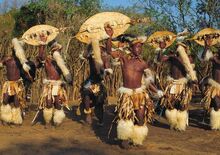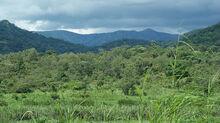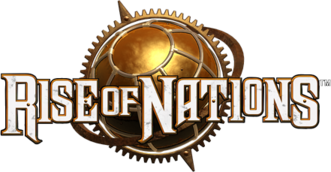| Nation Overview | Strategic Overview | CtW Information | History |

Zulu men performing Indlamu, also often referred to as the Zulu war dance, a traditional dance mostly associated with Zulu culture. It is derived from the Zulu warrior class of ancient times, and is carried out by men in full warrior regalia; traditional head pieces, ceremonial belts, shields and spears. The Zulu, and particularly its warriors, are one of the great influences on the depiction of the Bantu nation in the game.
The term Bantu, refers to a variety of tribes across most of Africa that speak any of the more than five hundred different languages and dialects of the Bantu family. Although they are as extense a number of peoples as they are diverse, the most recognizable Bantu ethnic group in popular culture, and the one Rise of Nations seems to be most based on, is that of the Zulu of southern Africa. In fact, the word itself derives from Abantu (or 'Bantu' as it was used by colonists) which is the word for people in the Zulu language. It is the plural of the word 'umuntu', meaning 'person', and is based on the stem '-ntu' plus the plural prefix 'aba'.
Rise of the Bantu

Gashaka Gumti National Park in Nigeria, and not far from Cameroon. It is around this area, the central border between both countries, that the Bantu peoples are believed to have originated, and to have begun their great, centuries-long journey that brought them to most of the African continent.
Current scholarly understanding places the ancestral proto-Bantu homeland in West Africa near the present-day southwestern border of Nigeria and Cameroon, around 4000 years ago (2000 BCE). It is unclear exactly when the spread of Bantu-speakers, called the "Bantu Expansion", began from their core area as hypothesized c. 5000 years ago (3000 BCE). By 3500 years ago (1500 BCE) in the west, Bantu-speaking communities had reached the great Central African rain forest, and by 2,500 years ago (500 BCE), pioneering groups had emerged into the savannahs to the south, in what are now the Democratic Republic of the Congo, Angola, and Zambia. Another stream of migration, moving east, by 3000 years ago (1000 BCE) was creating a major new population center near the Great Lakes of East Africa, where a rich environment supported a dense population. Movements by small groups to the southeast from the Great Lakes region were more rapid, with initial settlements widely dispersed near the coast and near rivers, due to comparatively harsh farming conditions in areas farther from water. Pioneering groups had reached modern KwaZulu-Natal in South Africa by 300 CE along the coast, and the modern Northern Province (encompassed within the former province of the Transvaal) by 500 CE.
The proto-Bantu migrants in the process assimilated and/or displaced a number of earlier inhabitants that they came across, including Pygmy and proto-Khoisan populations in the center and south, respectively. They also encountered some Cushitic- and Nilotic-speaking outlier groups in the southeast, who had migrated down from Northeast Africa, and Bantu-speakers may have adopted livestock husbandry from them, since herding practices reached the far south several centuries before Bantu-speaking migrants did. Archaeological, linguistic, genetic, and environmental evidence all support the conclusion that the Bantu expansion was a significant human migration.
The Iron Age
Iron Age technology was transmitted across Africa by Bantu-speaking people who migrated to the south from North and Central Africa. Their language and culture mixed with those of the groups they met, which is why many African people are Bantu-speaking. They also brought iron smelting technology and agriculture to these groups and founded great kingdoms like Great Zimbabwe, Mapungubwe and Thulamela. Before the Iron Age in southern Africa most people were nomadic and survived by hunting wild animals and gathering wild plants. Most chiefdoms were small in size and people did not regard land as property. This resulted in fairly harmonious co-existence as no tribe needed to be or was sufficiently more powerful to conquer another. Some scientists say this was helped by the abundance of resources. Food and water were readily available and people simply followed the animals they hunted as the seasons changed. This made the nomadic life more practical than settling in one place.
As agriculture grew people settled in villages and towns and gathered together their cattle in a kraal in the centre of the settlement. Their societies became more organised and political leaders emerged. They didn't have to rely on the availability of wild animals or plants any longer but could produce their own food. Farming allowed people to settle in towns. As towns grew and developed, society became more complex, paving the way for more sophisticated administration and politics. Now that communities could cultivate plant crops and raise livestock, especially cattle, they sometimes had too much of both.
This surplus became the object of trade. Groups began to exchange their products for goods they couldn't produce themselves. Trade routes were established and ivory and gold from Africa was traded for cloth, glass beads and other luxury products from afar.
Mediaeval Africa
The Arrival of Islam
Imperial Splendour
Trade and Commerce
The White Man's Burden
An Ongoing Saga
References
| This article is lacking the following important content: Expansion (pun intended) You can help improving this article by adding to it. |
